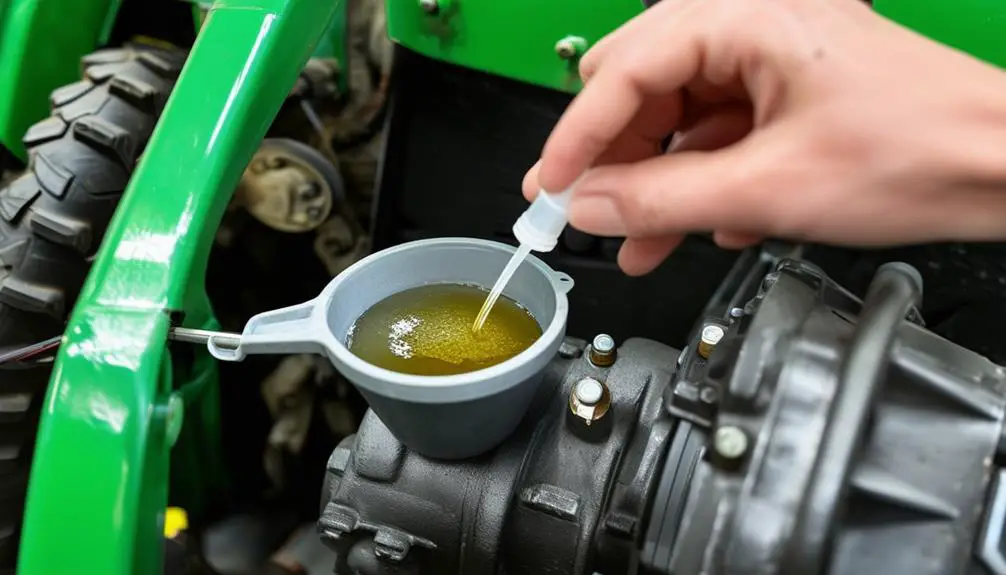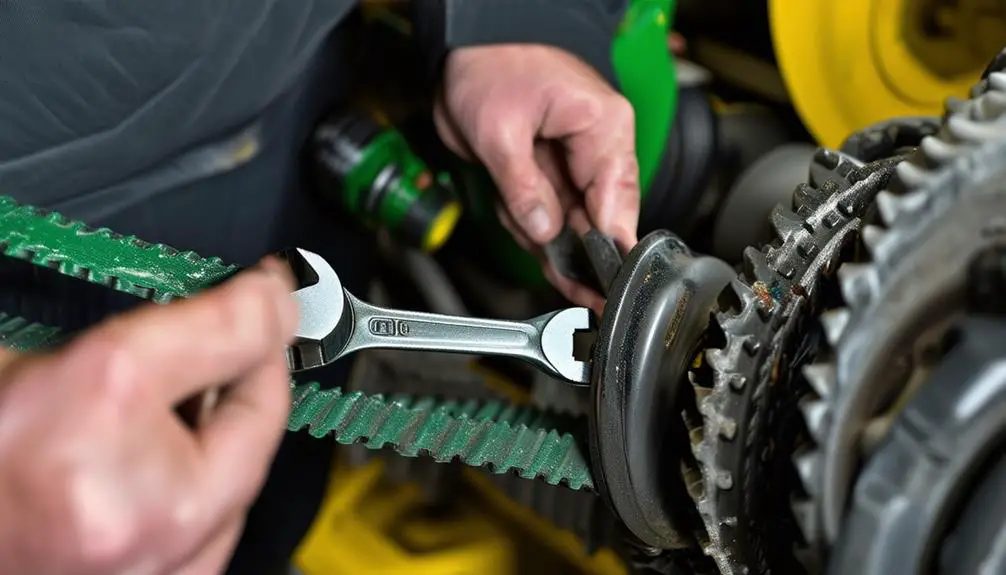If you're facing problems with your John Deere hydrostatic transmission, understanding the top three fixes can save you time and money. By focusing on checking and refilling the fluid level, replacing the filter on schedule, and inspecting and adjusting the belts, you can secure smoother operation and potentially avoid costly repairs. These fundamental maintenance tasks play a crucial role in keeping your transmission running efficiently and avoiding common problems.
Things to Note
- Check and refill fluid levels as per manufacturer's recommendations.
- Regularly replace the filter with genuine John Deere parts.
- Inspect belts for wear, adjust tension, and replace if damaged.
- Follow maintenance schedules to prevent costly repairs.
- Focus on fluid, filter, and belt maintenance for optimal performance.
Fluid Level Check and Refill

Check the fluid level in the John Deere hydrostatic transmission and refill if necessary. Maintaining proper fluid levels is essential for peak performance.
Start by parking your tractor on a flat surface and engaging the parking brake. Locate the transmission fluid reservoir, usually near the rear or under the seat. Remove the cap and use a dipstick to check the current fluid level.
If it's below the recommended level, add the appropriate type of fluid recommended by John Deere.
Filter Replacement
To maintain proper functionality, regularly replace the filter in your John Deere hydrostatic transmission according to the manufacturer's recommended schedule. The filter plays an essential role in keeping the transmission fluid clean and free from contaminants that can cause damage. Over time, the filter can become clogged or dirty, reducing the efficiency of the transmission system. By replacing the filter at the specified intervals, you optimize that your John Deere hydrostatic transmission operates smoothly and prolong its lifespan.
When replacing the filter, make sure to use a genuine John Deere filter to guarantee compatibility and best performance. Begin by locating the filter housing, typically found near the transmission unit. Follow the manufacturer's instructions for removing the old filter and installing the new one securely. Take care not to introduce any dirt or debris into the transmission system during the replacement process.
Regularly replacing the filter is a simple yet effective way to maintain your John Deere hydrostatic transmission and prevent potential problems down the line. By staying proactive with filter replacements, you can enjoy a trouble-free operation and maximize the performance of your equipment.
Belt Inspection and Adjustment

Maximize the peak performance of your John Deere hydrostatic transmission by regularly inspecting and adjusting the belts as needed. Proper belt inspection is important to promote smooth operation and prevent potential transmission issues.
Start by visually examining the belts for any signs of wear, cracks, or fraying. If you notice any damage, it's crucial to replace the belt promptly to avoid further problems.
Next, check the belt tension to ensure it's within the manufacturer's recommended specifications. Adjust the tension if necessary to maintain top performance. A loose belt can slip and cause inefficiencies, while an overly tight belt can put strain on the transmission components.
Regularly lubricate the pulleys and make sure they're aligned properly to prevent premature belt wear. Additionally, ensure the belt is correctly routed around all pulleys to prevent slippage and maintain efficient power transfer.
Frequently Asked Questions
How Often Should I Change the Hydrostatic Transmission Fluid?
You should change the hydrostatic transmission fluid in your John Deere regularly to maintain peak performance. Typically, it's recommended to replace the fluid every 200-250 hours of use.
This maintenance task helps prevent potential issues and keeps your transmission running smoothly. By following this schedule, you can extend the lifespan of your equipment and avoid costly repairs down the line.
Can I Use Any Type of Hydraulic Fluid in My John Deere Transmission?
Absolutely, utilizing any type of hydraulic fluid in your John Deere transmission can cause serious damage. Stick to the specified fluid to safeguard your equipment.
What Are the Signs of a Failing Hydrostatic Transmission?
If your hydrostatic transmission is failing, be on the lookout for signs like erratic speed changes, loss of power, strange noises, or leaking fluid. These symptoms can indicate underlying issues that need attention.
Don't ignore these warning signs; instead, consult a professional to diagnose and address the problem promptly.
Regular maintenance and timely repairs can help extend the life of your transmission and keep your equipment running smoothly.
Are There Any Common Issues Specific to John Deere Hydrostatic Transmissions?
Have you ever wondered about common issues specific to John Deere hydrostatic transmissions? These systems can sometimes experience problems like fluid leaks, loss of power, or erratic shifting.
It's important to keep an eye out for these issues and address them promptly to guarantee the smooth operation of your equipment.
Regular maintenance and timely repairs can help you avoid costly breakdowns and keep your John Deere running smoothly.
How Do I Prevent Overheating in My Hydrostatic Transmission?
To prevent overheating in your hydrostatic transmission, it is essential to maintain proper fluid levels and ensure sufficient cooling. Regularly checking for leaks and keeping the system clean are also crucial steps in preventing overheating issues. Avoiding overexertion of your equipment for prolonged periods and allowing for cool-down breaks during heavy use can significantly help in maintaining optimal operating temperatures. Monitoring the temperature gauge closely and addressing any sudden increases promptly is important for early detection of potential problems. By following these measures diligently, you can effectively avert overheating problems in your hydrostatic transmission.
Conclusion
To wrap up, by consistently checking and refilling the fluid level, replacing the filter, and inspecting and adjusting the belts, you can effectively address John Deere hydrostatic transmission problems.
Just like tending to a garden to promote its growth, maintaining these key components will help your transmission operate smoothly and efficiently for years to come.
Keep these fixes in mind to keep your John Deere equipment running at its peak.